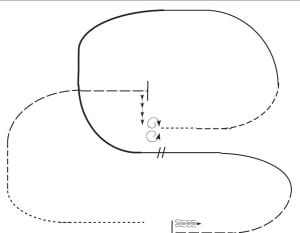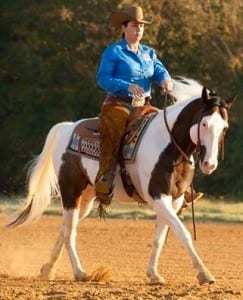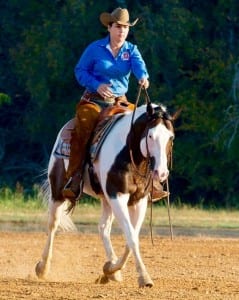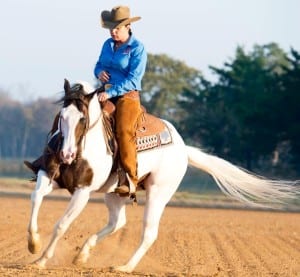As we all have seen Ranch Riding is becoming one of the fastest growing, most popular classes at the horse show. So, with so many different “style” horses being presented, how do the judges decipher the winner?
We are taught as judges a hierarchy, or priority, of judging that we utilize in every event:
1. Correctness
2. Quality
3. Degree of difficulty
Ranch riding is judged on a scale from plus 1 ½- to minus 1 ½ with a zero denoting “correct”. Each maneuver is assessed by the hierarchy; is it correct? How was the quality? Finally; was the degree of difficulty there? In order to discuss this hierarchy in more detail, we have chosen to breakdown each maneuver from Ranch Riding Pattern 3. Follow with the pattern posted below, pull out your rulebook or print out the pattern and follow along.
AQHA/APHA Ranch Riding Pattern 3
 1. Walk to the left around corner of the arena
1. Walk to the left around corner of the arena
2. Trot
3. Extend alongside of the arena and around the corner to center
4. Stop, sidepass right
5. 360 degree turn each direction (either way 1st)
6. Walk
7. Trot
8. Lope left lead
9. Extend the lope
10. Change leads (simple or flying)
11. Collect to the lope
12. Extend Trot
13. Stop and back
© 2016 AMERICAN QUARTER HORSE ASSOCIATION
The first maneuver is the walk; did the horse have a four beat flat footed walk and not break gait? If so, its CORRECT.
How was the quality? Did the horse travel straight? Was it willfully guided? Did it follow the pattern? If the answer is yes; then we have QUALITY which is credit earning.
Did the horse walk forward with a ground covering stride? I’m not using the term speed; I used the term in the rulebook forward, ground covering. If the horse moved with a forward, ground covering stride and remained CORRECT and maintained QUALITY and has now added DEGREE OF DIFFICULTY, this maneuver is credit earning.
2. Trot
We are looking for a straight line of travel, two beat trot to make this CORRECT. QUALITY is softness in movement, i.e. a horse that you can comfortably ride all day that is willfully guided. If the rider exhibits the horse with forward movement and maintains CORRECTNESS and QUALITY; then DEGREE OF DIFFICULTY has been added to earn credit.
 3. Extended trot to the center
3. Extended trot to the center
Did the rider present the gait correct without any break of gait penalties? Was the stride a lengthened two beat gait? If so the maneuver is CORRECT. A planned line of travel that takes the rider above center as the pattern depicts adds QUALITY. A soft moving, lengthened stride that is willfully guided adds DEGREE OF DIFFICULTY.
4. Sidepass Right
Let’s move to the fourth maneuver, “Stop and sidepass right”. Did the horse stop with his hind quarters square holding the ground? Did the horse step laterally moving both the front and rear feet crossing over? If so this maneuver is CORRECT.
Was the stop and side pass straight without resistance? Did the horse have cadence while sidepassing? If so, we have QUALITY.
Did the horse stop hard and the rider let the horse stand up for a split second then the rider move into a CORRECT, QUALITY sidepass adding speed? If so, and CORRECTNESS AND QUALITY were not sacrificed nor did the rider incur penalties; we have then met all three components of our judging hierarchy and should definitely earn credit.
The fifth maneuver calls for one spin each direction. Now, some people seem to think that faster is better. However, just like in the other maneuvers, speed is the last thing you need to focus on.
The same pattern applies here; CORRECTNESS – does the horse move willingly and correct stepping over? QUALITY OF MOVEMENT – does the horse flow? Then, DEGREE OF DIFFICULTY should be considered which would involve the speed of the spins.
6. Walk
It must be presented correctly with a four beat gait not incurring penalties. QUALITY; horse looking forward through the bridle with good expression, traveling on a straight line of travel between the reins. DEGREE OF DIFFICULTY; moving forward with lengthened stride not pacing.
7. Trot
It must be a two beat gait without penalties to meet the definition of correctness. Good expression, straight line of travel and beginning the transitions at the location as depicted on the diagram adds QUALITY to the maneuver. Forward, soft movement adds DEGREE OF DIFFICULTY.
A three beat gait without penalties makes this maneuver correct. Transitioning into the lope where the pattern shows, soft, quality movement, traveling on a straight planned line of travel adds QUALITY. Components that add DEGREE OF DIFFICULTY; a horse who rounds his back driving his hock under himself transitioning into the lope, moving forward with lengthened stride.
9. Extended Lope
Three beat, lengthened stride without incurring penalties defines a correct maneuver. Transitioning to the extended lope at the top center, soft quality movement that is willfully guided with a pleasant expression traveling on a straight line adds QUALITY. Rounding the back when asked to transition to the extended lope adding a lengthened stride that is under control will add DEGREE OF DIFFICULTY to the maneuver.
10. Lead Change
Now, I’d like to move to the tenth maneuver the lead change. This has been a questionable maneuver for many involved, on whether or not a simple lead change can earn as much credit as a flying?
Once again we will use our hierarchy to evaluate the lead change. The AQHA rulebook states under the horsemanship rules, “SHW436.6 A simple or flying change of lead should be executed precisely in the specified number of strides and/or at the designated location. A simple change of lead is performed by breaking to a walk or trot for one to three strides. Flying changes should be simultaneous front and rear. All changes should be smooth and timely.”
This rule describes CORRECT simple and flying lead changes; if a rider executes an incorrect flying or simple they will not earn credit.
If a rider executes a CORRECT, QUALITY simple in one stride they have added DEGREE OF DIFFICULTY; hence earning credit that can be as much as a flying that meets our requirements.
The horse must “shorten” its stride and maintain a three beat gait without incurring penalties to be a correct maneuver. A horse who travels a straight line where the pattern depicts, softly, willfully with good expression adds quality to this maneuver. The horse who shortens his stride after the lead change by rounding his back and holding a straight line until he is guided right adds DEGREE OF DIFFICULTY.
12. Downward Transition to Extended Trot
The horse must maintain a lengthened two beat stride to be considered CORRECT. Transitioning to the extended trot as the pattern depicts, softly, willfully, with good expression adds QUALITY. A horse who responds immediately to the rider’s cue to a soft extended trot that maintains the same rhythm until the next maneuver adds DEGREE OF DIFFICULTY.
13. Stop and Back
The horse must shift his weight to the hindquarters stopping square and back straight for a correct maneuver. To add QUALITY; the horse rounds his back responding softly and willfully. The horse who responds to the rider’s cue immediately, holds his hindquarters in the stop with authority, backing responsively with rhythm adds DEGREE OF DIFFICULTY.
In Summary
This pattern has 13 maneuvers as shown in the description. You’re being judged on each maneuver by the hierarchy CORRECTNESS, QUALITY, DEGREE OF DIFFICULTY. Performing the maneuver as written without incurring penalties makes for a correct maneuver. Pattern placement (riding the pattern as depicted in the diagram) and straight willfully guided lines are major components to QUALITY. Controlled speed and or lengthened stride, responsive to the rider, maintaining rhythm throughout the maneuver adds DEGREE OF DIFFICULTY.
Remember, once you have completed a maneuver it’s over; the judge has forgotten about it and is judging the remaining maneuvers. If you have an unsatisfactory maneuver forget about it; don’t let it ruin your remaining pattern. Show your horse to its best ability; highlighting its strengths and trying to score a zero on the weak components.













